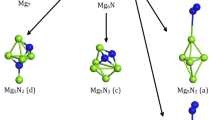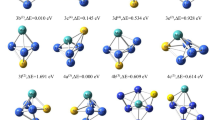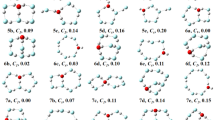Abstract
A detailed comprehensive theoretical study on the structures, electronic and spectroscopic properties of GeMgn+ (n = 2–12) clusters has been reported through CALYPSO program together with density functional theory (DFT). It is shown that the geometrical growth patterns of the ground state GeMgn+ clusters are tetrahedral-based in the size range of n from 5 to 7 and tent-based geometry at n = 8–12. GeMg8+ is found to has robust local stability and thus can be identified as a magic cluster. Charge transfer analysis indicates that germanium atoms are electron receivers in all clusters, while magnesium atoms are electron donors. Finally, the GeMg8+ has been further studied, including the relationship between its chemical bond properties and stability, infrared and Raman spectra.







Similar content being viewed by others
References
T. M. Bernhardt (2005). Gas-phase kinetics and catalytic reactions of small silver and gold clusters. Int. J. Mass Spectrom. 243 (1), 1–29.
W. A. D. Heer (1993). The physics of simple metal clusters: experimental aspects and simple models. Rev. Modern Phys. 65 (3), 611–676.
J. A. Alonso (2000). Electronic and atomic structure, and magnetism of transition-metal clusters. Chem. Rev. 100 (2), 637–678.
Y. **, S. Lu, A. Hermann, X. Kuang, C. Zhang, C. Lu, and W. Zheng (2016). Probing the structural evolution of ruthenium doped germanium clusters: photoelectron spectroscopy and density functional theory calculations. Sci. Rep. 6 (1), 30116–30116.
X. X. **a, X. Y. Kuang, L. Cheng, and A. Hermann (2016). Deciphering the structural evolution and electronic properties of magnesium clusters: an aromatic homonuclear metal Mg17 cluster. J. Phys. Chem. A 120 (40), 7947–7954.
Y. Tian, D. Wei, Y. **, J. Barroso, C. Lu, and G. Merino (2019). Exhaustive exploration of MgBn (n = 10–20) clusters and their anions. Phys. Chem. Chem. Phys. 21 (13), 6935–6941.
S. **, B. Chen, X. Kuang, C. Lu, W. Sun, X. **a, and G. L. Gutsev (2019). Structural and electronic properties of medium-sized aluminum-doped boron clusters AlBn and their anions. J. Phys. Chem. C 123 (10), 6276–6283.
J. Li, X. Li, H. Zhai, and L. Wang (2003). Au20: a tetrahedral cluster. Science 299 (5608), 864–867.
W. Sun, J. J. Wang, C. Lu, X. X. **a, X. Kuang, and A. Hermann (2017). Evolution of the structural and electronic properties of medium-sized sodium clusters: a honeycomb-like Na20 cluster. Inorg. Chem. 56 (3), 1241–1248.
X. **ng, A. Hermann, X. Kuang, M. Ju, C. Lu, Y. **, and G. Maroulis (2016). Insights into the geometries, electronic and magnetic properties of neutral and charged palladium clusters. Sci. Rep. 6 (1), 19656–19656.
Y. **, Y. Tian, X. Kuang, C. Zhang, C. Lu, J. Wang, and M. Ju (2015). Ab initio search for global minimum structures of pure and boron doped silver clusters. J. Phys. Chem. A 119 (25), 6738–6745.
Y. **, G. Maroulis, X. Kuang, L. Ding, C. Lu, J. Wang, et al. (2015). Geometries, stabilities and fragmental channels of neutral and charged sulfur clusters: Snq (n = 3–20, q = 0, ±1). Phys. Chem. Chem. Phys. 17 (20), 13590–13597.
W. Sun, X. **a, C. Lu, X. Kuang, and A. Hermann (2018). Probing the structural and electronic properties of zirconium doped boron clusters: Zr distorted B12 ligand framework. Phys. Chem. Chem. Phys. 20 (36), 23740–23746.
C. Bole, S. Weiguo, K. **ao-Yu, L. Cheng, X. **nxin, S. Hongxiao, and G. Maroulis (2018). Structural stability and evolution of medium-sized tantalum-doped boron clusters: a half-sandwich-structured TaB12– cluster. Inorg. Chem. 57 (1), 343–350.
X. X. **a, A. Hermann, X. Y. Kuang, Y. Y. **, C. Lu, and X. D. **ng (2015). Study of the structural and electronic properties of neutral and charged niobium-doped silicon clusters: niobium encapsulated in silicon cages. J. Phys. Chem. C 120 (1), 677–684.
X. **ng, J. Wang, X. Kuang, X. **a, C. Lu, and G. Maroulis (2016). Probing the low-energy structures of aluminum–magnesium alloy clusters: a detailed study. Phys. Chem. Chem. Phys. 18, 26177–26183.
O. C. Thomas, W. J. Zheng, S. J. Xu Jr., and K. H. Bowen (2002). Onset of metallic behavior in magnesium clusters. Phys. Rev. Lett. 89, 213403.
I. Heidari, S. De, S. M. Ghazi, S. Goedecker, and D. G. Kanhere (2011). Growth and structural properties of MgN (N=10-56) clusters: density functional theory study. J. Phys. Chem. A 115 (44), 12307–12314.
A. Köhn, F. Weigend, and R. Ahlrichs (2001). Theoretical study on clusters of magnesium. Phys. Chem. Chem. Phys. 3 (5), 711–719.
R. W. P. Wagemans, J. H. V. Lenthe, P. E. D. Jongh, A. J. V. Dillen, and K. P. D. Jong (2006). Hydrogen storage in magnesium clusters: quantum chemical study. J. Am. Chem. Soc. 127, 16675–16680.
R. Trivedi and D. Bandyopadhyay (2015). Hydrogen storage in small size MgnCo clusters: a density functional study. Int. J. Hydrog. Energy 40 (37), 12727–12735.
A. Gupta and D. Sa (2016). Thermoelectric transport in the topological phase due to the coexistence of superconductivity and spin-density-wave. Eur. Phys. J. B 89 (1), 1–6.
J. Mao, H. S. Kim, J. Shuai, Z. Liu, R. He, U. Saparamadu, F. Tian, W. Liu, and Z. Ren (2016). Thermoelectric properties of materials near the band crossing line in Mg2Sn–Mg2Ge–Mg2Si system. Acta Mater. 103, 633.
J. I. Tani and H. Kido (2008). Lattice dynamics of mg2si and mg2ge compounds from first-principles calculations. Comput. Mater. Sci. 42 (3), 531–536.
J. J. Martin (1972). Thermal conductivity of Mg2Si, Mg2Ge and Mg2Sn. J. Phys. Chem. Solids 33 (4), 1139–1148.
J. L. Corkill and M. L. Cohen (1993). Structural, bonding, and electronic properties of iia-iv antifluorite compounds. Phys. Rev. B: Condensed Matter 48 (23), 17138–17144.
F. Yu, J. X. Sun, and T. H. Chen (2011). High-pressure phase transitions of mg2ge and mg2sn: first-principles calculations. Phys. B: Phys. Condensed Matter 406 (9), 1789–1794.
F. Kalarasse and B. Bennecer (2008). Electronic and optical properties of the antifluorite semiconductors Be2C and Mg2X (x=C, Si, Ge) under hydrostatic pressure. J.. Phys. Chem. Solids 69 (7), 1775–1781.
Y. Wang, J. Lv, L. Zhu, and Y. Ma (2010). Crystal structure prediction via particle-swarm opti- mization. Phys. Rev. B 82, 094116.
Y. Wang, J. Lv, L. Zhu, and Y. Ma (2012). Calypso: a method for crystal structure prediction. Comput. Phys. Commun. 183 (10), 2063–2070.
J. Lv, Y. Wang, L. Zhu, and Y. Ma (2012). Particle-swarm structure prediction on clusters. J. Chem. Phys. 137 (8), 084104.
M. Ju, J. Lv, X. Y. Kuang, L. P. Ding, C. Lu, J. J. Wang, and G. Maroulis (2015). Systematic theoretical investigation of geometries, stabilities and magnetic properties of iron oxide clusters (FeO)nμ (n= 1–8, μ= 0,±1): insights and perspectives. RSC Adv. 5 (9), 6560–6570.
C. Lu and C. Chen (2020). Indentation-strain stiffening in tungsten nitrides: mechanisms and implications. Phys. Rev. Mater. 4, 043402.
C. Lu and C. Chen (2020). Structure-strength relations of distinct MoN phases from first-principles calculations. Phys. Rev. Mater. 4, 044002.
L. P. Ding, F. H. Zhang, Y. S. Zhu, C. Lu, X. Kuang, J. Lv, and P. Shao (2015). Understanding the structural transformation, stability of medium-sized neutral and charged silicon clusters. Sci. Rep. 5 (1), 15951–15951.
P. Li, T. Mei, L. Lv, C. Lu, W. Wang, G. Bao, and G. L. Gutsev (2017). Structure and electronic properties of neutral and negatively charged RhBn clusters (n = 3–10): a density functional theory study. J. Phys. Chem. 121 (34), 6510–6516.
C. Lu, Q. Li, Y. Ma, and C. Chen (2017). Extraordinary indentation strain stiffening produces superhard tungsten nitrides. Phys. Rev. Lett. 119 (11), 115503.
Y. Sun, J. Lv, Y. **e, H. Liu, and Y. Ma (2019). Route to a superconducting phase above room temperature in electron-doped hydride compounds under high pressure. Phys. Rev. Lett. 123 (9), 097001.
C. Lu and C. Chen (2018). High-pressure evolution of crystal bonding structures and properties of FeOOH. J. Phys. Chem. Lett. 135 (38), 14167–14171.
C. Lu, A. Maximilian, and C. Changfeng (2018). Unraveling the structure and bonding evolution of the newly discovered iron oxide FeO2. Phys. Rev. B 98, 054102.
A. D. Becke (1998). Density-functional exchange-energy approximation with correct asymptotic behavior. Phys. Rev. A 38 (38), 3098–3100.
C. Lee, W. Yang, and R. G. Parr (1988). Development of the Colle-Salvetti correlation-energy formula into a functional of the electron density. Phys. Rev. B 37 (2), 785–789.
K. L. Schuchardt, B. T. Didier, T. Elsethagen, L. Sun, V. Gurumoorthi, J. Chase, J. Li, and L. T. Windus (2007). Basis set exchange: a community database for computational sciences. J. Chem. Inf. Model. 47, 1045–1052.
M. J. Frisch, G. W. Trucks, H. B. Schlegel, G. E. Scuseria, M. A. Robb, J. R. Cheeseman, G. Scalmani, V. Barone, G. A. Petersson, H. Nakatsuji, X. Li, M. Caricato, A. Marenich, J. Bloino, B. G. Janesko, R. Gomperts, B. Mennucci, H. P. Hratchian, J. V. Ortiz, A. V. Izmaylov, J. L. Sonnenberg, D. Williams-Young, F. Ding, F. Lipparini, F. Egidi, J. Goings, B. Peng, A. Petrone, T. Henderson, D. Ranasinghe, V. G. Zakrzewski, J. Gao, N. Rega, G. Zheng, W. Liang, M. Hada, M. Ehara, K. Toyota, R. Fukuda, J. Hasegawa, M. Ishida, T. Nakajima, Y. Honda, O. Kitao, H. Nakai, T. Vreven, K. Throssell, J. A. Montgomery Jr., J. E. Peralta, F. Ogliaro, M. Bearpark, J. J. Heyd, E. Brothers, K. N. Kudin, V. N. Staroverov, T. Keith, R. Kobayashi, J. Normand, K. Raghavachari, A. Rendell, J. C. Burant, S. S. Iyengar, J. Tomasi, M. Cossi, J. M. Millam, M. Klene, C. Adamo, R. Cammi, J. W. Ochterski, R. L. Martin, K. Morokuma, O. Farkas, J. B. Foresman, and D. J. Fox, Gaussian 09, revision A.02 (Gaussian, Inc., Wallingford, CT, 2009).
A. E. Reed, L. A. Curtiss, and F. Weinhold (1988). Intermolecular interactions from a natural bond orbital, donor-acceptor viewpoint. Chem. Rev. 88 (6), 899–926.
A. E. Reed, R. B. Weinstock, and F. Weinhold (1998). Natural population analysis. J. Chem. Phys. 83 (2), 735–746.
T. Lu and F. Chen (2012). Multiwfn: a multifunctional wavefunction analyzer. J. Comput. Chem. 33, 580–592.
D. Y. Zubarev and A. I. Boldyrev (2008). Develo** paradigms of chemical bonding: adaptive natural density partitioning. Phys. Chem. Chem. Phys. 10 (34), 5207–5217.
M. Kabir, A. Mookerjee, and D. G. Kanhere (2006). Structure, electronic properties, and magnetic transition in manganese clusters. Phys. Rev. B Condensed Matter Mater. Phys. 73 (22), 224439.
Acknowledgements
This work is partly supported by National Innovation and Entrepreneurship Training Program for College Students Grant No. 202010920018. Y.H.Liao acknowledges the support from The Scientific and Technological Research Program of Education Department of Hubei Province Grant no. B20172611 and Excellent Talents Foundation of Hubei Polytechnic University Grant no.16xjz01c. Furthermore, this work is also partly supported by the project of Fundamental Research Funds for the Central Universities (No. 2019CDYGYB011).
Author information
Authors and Affiliations
Corresponding authors
Additional information
Publisher's Note
Springer Nature remains neutral with regard to jurisdictional claims in published maps and institutional affiliations.
Rights and permissions
About this article
Cite this article
Liao, YH., Guo, J., Deng, PJ. et al. Decrypting the Structural, Electronic and Spectroscopic Properties of GeMgn+(n = 2–12) Clusters: A DFT Study. J Clust Sci 33, 1093–1101 (2022). https://doi.org/10.1007/s10876-021-02039-y
Received:
Accepted:
Published:
Issue Date:
DOI: https://doi.org/10.1007/s10876-021-02039-y




